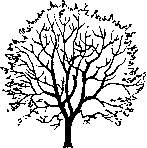 Pacific crab apple
Pacific crab apple
Malus fusca (Raf) Schneid.
Introduction
Pacific crab apple is a small tree or multi-stemmed shrub that grows up to 12 m tall. It is found along the coast, from sea level to mid elevations, on moist sites and along rivers (Parish et al. 1994). The species has no commercial uses and information about it is limited. Malus fusca possesses valuable polygenic resistance to fireblight (Erwinia amylovora) (Aldwinckle and Van Der Zwet 1979), an important disease on commercial apple varieties, as well as a high resistance to mildew (Podosphaera leucotricha) (Vujanic-Varga and Ognjanov 1988). As such, it is of interest for apple breeding. The hard, resilient wood was used by first peoples for making implements (Turner 1979). The apples, stored in water for preservation, were an important food. Some apple trees grew in carefully tended orchards. Imported apples were readily adopted and cultivated (Turner 1995).
The natural range of Pacific crab apple consists of a coastal belt from South Alaska to Northwest California. Somewhat less than half of the total range is located in British Columbia (Little 1976).
Distribution and Protected Areas – from Hamann et.al. 2005



In situ Conservation Status Summary – from Chourmouzis et.al. 2009
“Pacific crab apple occurs in coastal British Columbia, mainly in the CDF and CWH zones, with some extension into the ICH zone on the north coast. It is well protected in the CWH zone. While protection is low in both the ICH and CDF zones, Pacific crab apple is identified as a potential species of concern and is recommended for ground truthing only in the ICH zone. A comprehensive re-evaluation of protection status and needs for this species in the CDF zone is recommended prior to field verification in the zone.”
Ex situ collections
Ex situ collections are likely present in the form of germplasm collections for horticulture breeding programs (Paulin et al. 1983; Fischer 1994) but how extensive these are and how relevant to conservation of the native species as a whole, remains to be investigated.
Reproduction
The interval between good seed crops is two to four years (Banerjee et al. 2001).
Genetic structure
Isozyme analysis has revealed large genetic differences between Pacific crab apple and the eastern North American apples, as well as between native and cultivated apples, indicating little gene flow from cultivated apples into native Malus (Dickson et al. 1991).
Resource management and seed transfer
No information available.
REFERENCES
Hamann, A., Smets, P., Aitken, S. N. and Yanchuk, A. D. 2005. An ecogeographic framework for in situ conservation of forest trees in British Columbia. Can. J. For. Res. 35:2553-2561. View online resources for this report.
C. Chourmouzis, A.D. Yanchuk, A. Hamann, P. Smets, and S.N. Aitken. 2009. Forest Tree Genetic Conservation Status Report 1: In situ conservation status of all indigenous BC species. Centre for Forest Conservation Genetics, Forest Genetics Council of BC, and BC Ministry of Forests and Range, Forest Science Program, Victoria, BC Technical Report 053. www.for.gov.bc.ca/hfd/pubs/Docs/Tr/Tr053.htm
Aldwinckle, H. S. and Van Der Zwet, T. 1979. Recent progress in breeding for fire blight resistance in apples and pears in North America. Bulletin OEPP (Organisation Europeenne et Mediterraneenne Pour la Protection des Plantes) 9:27-34.
Banerjee, S. M., Creasy, K. and Gertzen, D. D. 2001. Native woody plant seed collection guide for British Columbia. Crown Publications, Victoria. 147 p.
Dickson, E. E., Kresovich, S. and Weeden, N. F. 1991. Isozymes in North American Malus (Rosaceae) – hybridization and species differentiation. Systematic Botany 16:363-375.
Fischer, C. 1994. Using wild Malus species and apple cultivars for breeding for resistance. [German]. Erwerbsobstbau 36:208-212.
Little, E. L., Jr. 1976. Atlas of United States trees, volume 3, minor western hardwoods. U.S. Department of Agriculture Miscellaneous Publication 1314. 13 p., 290 maps.
Parish, R., Thomson, S. M., Coward, G. 1994. Tree book: learning to recognize trees of British Columbia. Canadian Forest Service, Victoria, B.C. 183 p.
Paulin, J. P., Thibault, B., Lezec, M. and Lespinasse, Y. 1983. Breeding for fire blight resistance. [French]. Agronomie 3:1-90.
Turner, N. J. 1979. Plants in British Columbia Indian technology. B.C. Provincial Museum Handbook no. 38. BC Provincial Museum, Victoria, B.C. 304 p.
Turner, N. J. 1995. Food plants of coastal First Peoples. Handbook – Royal British Columbia Museum. UBC Press, Vancouver. 164 p.
Vujanic-Varga, D. and Ognjanov, V. 1988. Resistance of some wild species of Malus Mill. to scab and powdery mildew. [Serbo-Croatian]. Jugoslovensko Vocarstvo 22:83-87.
